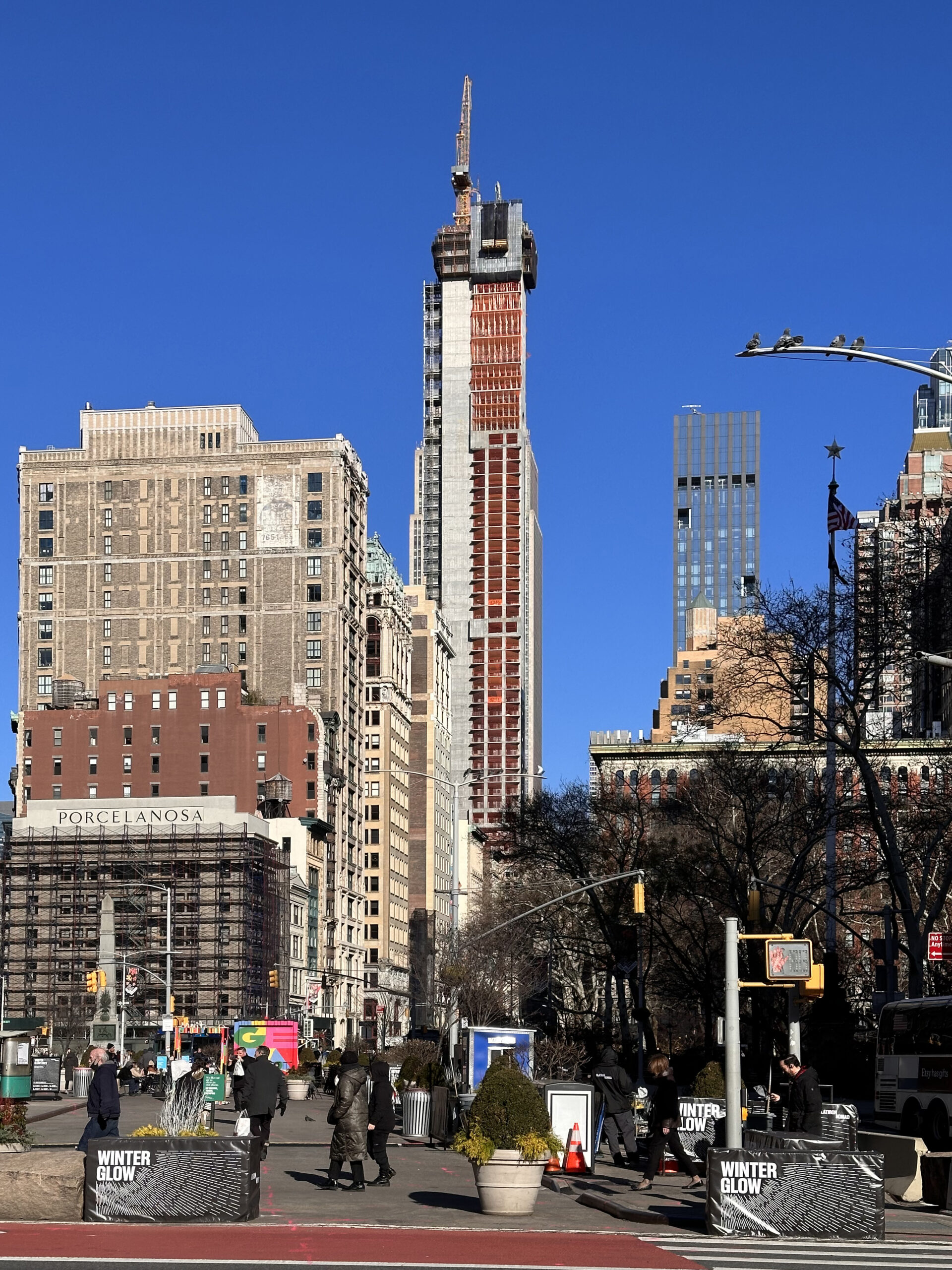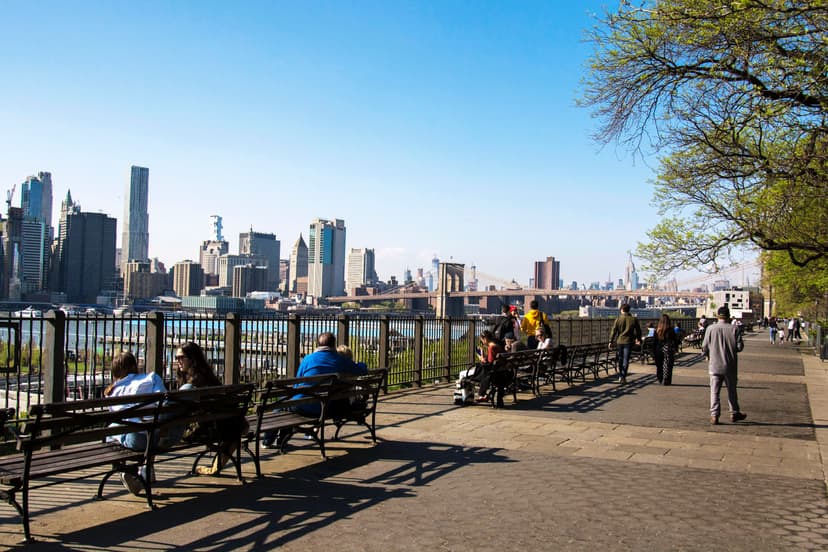
New York City's skinniest (and most hated) building
Stand in Madison Square Park today and look north. You won't see the Empire State Building. Instead, you'll see 262 Fifth Avenue, an 860-foot needle of glass barely 45 feet wide that now blocks one of New York's most beloved views. This is the result of zoning laws that protect buildings but don't specifically protect the views around them.
Here's what makes this particularly notable: 262 Fifth Avenue houses just 26 apartments. This 54-story tower consumed over $180 million in construction costs, blocks a view enjoyed by millions for nearly a century, and serves fewer people than a typical four-story walk-up. Each residence gets roughly 33,000 square feet of constructed space—an unprecedented ratio of building resources to residents.
The building's proportions are equally extreme. With a slenderness ratio of 19:1, it's officially NYC's skinniest building. Most floors measure just 45 by 45 feet, creating 2,025-square-foot apartments floating in the sky. Some units feature 47-foot ceiling heights. It's an impressive engineering achievement that highlights the tension between architectural innovation and housing density.
What's important to understand: 262 Fifth Avenue is completely legal. NYC's C5-3 zoning permits unlimited height above certain coverage thresholds. No variance required. No special permits. No public review for view impact. The developer assembled air rights, filed the permits, and built. The system worked as it was designed to work.
How to build a 19:1 needle in Manhattan
The physics alone are impressive. A 54-story tower squeezed onto a 45-by-45-foot footprint creates a slenderness ratio of 19:1. For comparison, most residential towers aim for ratios under 10:1. This is a pencil standing on its eraser, held upright by engineering wizardry and a massive spring damper system that acts as a gyroscope against wind loads.
Most floors are entirely column-free. All structural support and mechanical systems concentrate in a western core, leaving eastern spaces completely open. Each floor becomes a 2,025-square-foot box floating 600+ feet in the air, with 47-foot ceiling heights on some levels. The eastern elevation features oversized circular windows locals call "portholes." A 70-foot golden oculus crowns the top, allowing wind to pass through rather than creating dangerous street-level gusts.
But the engineering achievement masks a more significant issue: location. The tower sits precisely in the sight line between the Flatiron District and the Empire State Building.This wasn't an accident. The site was chosen specifically because C5-3 zoning at this location permits unlimited height. The view obstruction was predictable and preventable. Nobody stopped it because NYC's zoning code doesn't recognize view protection as a legitimate planning concern.
Stand in Madison Square Park now and you'll see reflective glass where the Empire State Building should be. The irony is brutal: the Empire State Building itself lacks landmark protection. It could theoretically be demolished tomorrow. But 262 Fifth Avenue's view obstruction is permanent and entirely legal.
The zoning code that forgot about views
New York protects exactly one view: the Brooklyn Heights Promenade's sight lines to Lower Manhattan, established in 1953.That's it. One view corridor in the entire city. The Empire State Building? Unprotected. The Chrysler Building? Unprotected. Central Park sight lines? Unprotected. NYC treats views as private commodities, not public assets.

C5-3 zoning, which governs the 262 Fifth Avenue site, permits a base Floor Area Ratio of 15. That's among the highest densities in the world. No height limit exists above certain coverage thresholds. No variance required. No special permits. No public review for view impact. Once a developer assembles the air rights and files the permits, construction can proceed—even if it blocks significant views.
The only public input for 262 Fifth Avenue came during a parking dispute. The developer wanted 23 parking spaces. Zoning permitted five. Community Board 5 and Manhattan Borough President Mark Levine rejected the application. Under current zoning regulations, parking decisions require community review while view impacts do not.This reflects the city's prioritization of property rights and density over view preservation.
London has protected 25 strategic views since 1938, including eight corridors to St. Paul's Cathedral from locations up to 10 miles away. The policy shaped buildings like the "Cheesegrater" (Leadenhall Building), which leans back to preserve sight lines. Paris reinstated a 12-story height limit citywide. Vancouver maintains 24 protected "view cones." NYC has one.
The difference is philosophical. NYC's planning system prioritizes private property rights and development flexibility over view protection.Views are treated as market commodities that can be bought, sold, and blocked by whoever assembles enough air rights. Air rights transfers let developers accumulate unused development capacity from multiple properties, enabling extreme height and slenderness. This approach allows buildings like 262 Fifth Avenue: towers that maximize vertical space to serve a small number of residents.
26 apartments for $180 million
Let's talk about the absurd economics. 262 Fifth Avenue cost over $180 million to build and houses 26 apartments.That's roughly $7 million in construction costs per unit before land, financing, or any other expenses. Each residence consumes approximately 33,000 square feet of constructed space. A typical four-story walk-up houses more people with a fraction of the material and energy consumption.
The units average 3,200 square feet, which sounds reasonable until you realize they're stacked vertically on a 45-by-45-foot footprint.The largest unit is a 9,600-square-foot quadruplex with a private pool spanning four floors of this needle-thin tower.Initial pricing ranges from $9.15 million to $23.25 million, or $4,100 to $8,220 per square foot. Sales launched in December 2024 with just five of 26 units priced, suggesting the market isn't exactly clamoring for $15-20 million apartments in NYC's most hated building.
The engineering is impressive. Triple-glazed floor-to-ceiling windows. Reflective aluminum panels. A massive spring damper system acting as a gyroscope. Column-free layouts maximizing those stolen Empire State Building views. But engineering prowess doesn't justify resource waste. Each of these 26 residents consumes the carbon footprint and material resources of a small apartment building while contributing nothing to NYC's housing supply.
Urban planning experts have noted that the resources needed per person to build such a tower are excessive and wasteful. This isn't just about blocking views. It's about a zoning system that permits enormous resource consumption to benefit 26 households while degrading public amenities enjoyed by millions.
When public heritage becomes private amenity
Residents expressed frustration and anger at the loss of the iconic view.Many described standing near the Flatiron Building, staring at where the Empire State Building used to be visible, now blocked by the new tower.For those who previously enjoyed the view from their apartments, the loss felt like a privilege that had been suddenly taken away.
The reaction goes beyond aesthetics. Madison Square Park and the Fifth Avenue corridor represented democratic spaces where millions of residents and tourists could access one of the world's great urban views at no cost. That public amenity now belongs exclusively to 26 households who paid $9-23 million for the privilege. The situation raises questions about balancing private property rights with public access to iconic urban views.
TikTok videos criticizing the tower went viral, with urban planner Dr. T. Panova highlighting "the impact on the city's charm and the experiences of millions." Travel publications warned tourists about the blocked views. Online commenters and architecture critics described it as one of the most hated buildings in NYC, emblematic of the pencil tower trend's worst impacts.
Community response was strong but faced legal constraints. Community Board 5 opposed the parking variance. Borough President Mark Levine rejected it on environmental grounds. Major preservation organizations like the Municipal Art Society and Historic Districts Council took no formal action, recognizing the limited legal options. The building was completely compliant with zoning regulations, operating within the framework of existing law.
Christopher Bonanos of Curbed compared the building's proportions to "Eberhard Faber" pencils. Critics noted the contrast between extreme engineering and limited housing contribution. The tower consumes enormous material and energy resources while housing fewer people than a typical four-story townhouse. Under current zoning regulations, considerations of efficiency, sustainability, and public benefit are not mandated criteria. Height and air rights are the primary determining factors.
Every view will eventually disappear
262 Fifth Avenue may represent a broader trend.Current zoning regulations allow for similar development patterns: ultra-luxury residential towers with limited units but significant visual impact. Nothing in the system prevents similar projects across Midtown, the Financial District, and other areas where C5-3 zoning permits unlimited height.
Think about what that means. Every iconic view in Manhattan is vulnerable to the same fate as the Empire State Building from Madison Square Park. The Chrysler Building from Grand Central. The skyline from Central Park. The bridges from waterfront parks. None of these sight lines have legal protection. All of them can disappear the moment a developer assembles enough air rights.

Similar projects are rising across Manhattan. Supertall pencil towers on 57th Street. Needle-thin residential towers in Midtown. Each one maximizes height, minimizes footprint, and serves a small number of residents. The cumulative effect has been a transformation of Manhattan's skyline and the viewing experiences from many traditional vantage points.
Proposals for view corridor protection exist but face complex challenges. Councilman Mark Levine's shadow impact legislation documents view impacts. The Municipal Art Society's "Accidental Skyline" reports study the changes. However, balancing property rights, development needs, and view protection involves competing interests and priorities, making reform politically challenging.
NYC could implement view corridor overlay districts tomorrow.The Brooklyn Heights Promenade proves the system can work. Protected sight lines to key landmarks with graduated height restrictions. View impact assessments in environmental review. Transfer development rights to compensate property owners. The technical solutions exist. London protects 25 views. Paris reinstated height limits. Vancouver maintains 24 view cones. NYC protects one.
The question is about priorities and trade-offs. Current zoning treats views as market commodities that can be affected by whoever assembles sufficient air rights. This reflects NYC's long-standing approach to development, which prioritizes property rights and density. Whether to change this approach involves balancing multiple competing values.
262 Fifth Avenue blocks the Empire State Building from Madison Square Park. Without changes to zoning regulations, other iconic views could face similar impacts. The current system allows for such development wherever the zoning permits unlimited height and developers can assemble the necessary air rights.
Conclusion
262 Fifth Avenue demonstrates how NYC's planning system balances development rights with public amenities. The building's engineering is remarkable. The impact on Manhattan's visual landscape is permanent. The blocked Empire State Building views will remain obscured for the tower's lifespan, transforming a century-old public viewing experience into an exclusive private vista for 26 households.
The controversy highlights ongoing debates about NYC's approach to skyline management. Supertall towers reshape Manhattan's profile and affect views from public spaces, which current regulations don't specifically protect. Other major cities take different approaches: London balances development with heritage protection. Paris reinstated height limits. Vancouver maintains view cones. NYC lets the market decide.
Whether NYC learns from 262 Fifth Avenue remains uncertain. The building is completely legal under current zoning. No retroactive changes are possible. But its example could catalyze the view corridor protection that preservationists have advocated for decades.The alternative is a Manhattan where iconic views disappear one project at a time, privatized by whoever assembles sufficient air rights.
New Yorkers visiting Madison Square Park now confront a new reality: their Empire State Building view belongs to someone else. In a city where public space remains precious and democratic access to beauty matters, that transformation represents a fundamental question about what kind of city NYC chooses to become.
26 apartments. $180 million. One disappeared view. And a zoning system that guarantees it will happen again.
Better tools for a better built world
Understanding view protection and urban planning is crucial for modern construction projects. Discover how advanced research tools like Atria can help architects and developers navigate complex regulatory requirements and make better-informed decisions from the earliest stages of design.